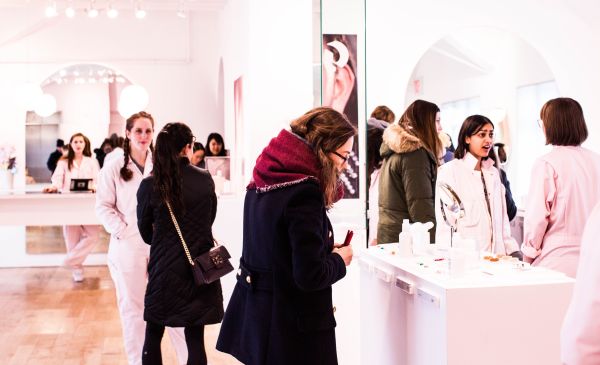Members of every culture adorn their bodies with artifacts like clothing and jewelry, and change these out to suit their moods or social demands. But today, we don’t just put things on; we put things in. Permanent tattoos, breast, lip, buttock and cheek implants, artificial hips, pacemakers, and embedded computer chips obliterate the traditional boundary between what we’re born with and what we own. The body is morphing into a product delivery platform. In a very real sense, we are what we own and we own what we are. The wall between our physical bodies and our possessions has never been more tenuous.
You Are What You Buy
Way back in 1890, the pioneering psychologist William James wrote, “A man’s self is the sum total of all that he can call his.” And that was before iPhones, Diesel jeans, and hoverboards!
When researchers asked children of various ages to create “who am I?” collages, for which they chose pictures that represented their selves, older kids between middle childhood and early adolescence were more likely to insert photos of branded merchandise. Also, as they aged, their feelings about these objects evolved from concrete relationships (e.g., “I own it”) to more sophisticated, abstract relationships (e.g., “It is like me”).
We are attached to an object when we rely on it to maintain our self-concept. Objects act as a security blanket when they reinforce our identities, especially in unfamiliar situations. For example, students who decorate their dorm rooms with personal items are less likely to drop out of college. This coping process may protect the self from being diluted in a strange environment.
Self-image congruence models suggest that we choose products when their attributes match some aspect of the self. And, when we choose a product that we think is aesthetically pleasing, this choice makes us feel better about ourselves. Indeed recent research that included brain wave measures such as functional magnetic resonance imaging (fMRI) showed that when a person has a close relationship with a brand this activates the insula, a brain area responsible for urging, addiction, loss aversion, and interpersonal love.
These emotional connections make people defensive of their favorite brands if they come across negative information about them. A comment by a respondent (a 32-year-old male) in one study nicely illustrates this bond: “My BMW is my wingman, my twin. I would never diss it for another car because that would be like dissing my twin brother or worse, dissing myself.”
This guy’s fondness for his vehicle is hardly unique; more than a third of Americans have nicknames for their cars. That bond explains the wording of a recent TV commercial for SafeAuto insurance as a Mom drives her kids around in a well-used minivan: “For years you and this supercharged piece of eye candy have done much more than make car payments, buy gas and change the oil. You’ve lived, really lived, and you’re most certainly not done . . .”
Congruence models assume a process of cognitive matching between a product’s attributes and the consumer’s self-image. Over time we tend to form relationships with products that resemble the bonds we create with other people: These include love, unrequited love (we yearn for it but can’t have it), respect, and perhaps even fear or hate (“why is my computer out to get me?”). Studies even report that after a “breakup” with a brand, people tend to develop strong negative feelings and will go to great lengths to discredit the item, including bad-mouthing and even vandalism.
Research largely supports the idea of congruence between product usage and self-image. One of the earliest studies to examine this process found that car owners’ ratings of themselves tended to match their perceptions of their cars: Pontiac drivers saw themselves as more active and flashy than did Volkswagen drivers. Indeed, a German study found that observers were able to match photos of male and female drivers to pictures of the cars they drove almost 70 percent of the time. Researchers also report congruity between consumers and their most preferred brands of beer, soap, toothpaste, and cigarettes relative to their least preferred brands, as well as between consumers’ self-images and their favorite stores.
The Body As A Billboard
The body truly has become a blank canvas for people to alter at will. Technology removes much of the risk from momentous decisions we used to fret over: “Should I change my hair color?” “How will I look in those expensive glasses?” “Do those jeans make me look fat?” True, these questions are not exactly on the same scale as “How do I bring about world peace?,” but they certainly cause a lot of anguish for many of us. But rest easy, because help is here. Today a plethora of websites like dailymakeover.com and myvirtualmodel.com offer a risk-free way to modify your hair, makeup, glasses, and even physical dimensions like bust size.
The calculus of perceived risk — will this product hurt me, bankrupt me, embarrass me? – – is one of the most important considerations of any purchase, Therefore, shortcuts that allow a buyer to view the outcome before committing to it potentially will transform the decision-making landscape for many products and services beyond hairstyles or tight blue jeans.
Think about the potential for home furnishings, plastic surgery, customized car design, and virtually any other purchase that requires a leap of faith today. Embrace technologies that allow your customers to reduce perceived risk, and you knock down a huge barrier to purchase.
Contributed to Branding Strategy Insider by: Michael Solomon. Excerpted and adapted from his book “Marketers, Tear Down These Walls!.” iBooks.
The Blake Project Can Help: Accelerate Brand Growth Through Powerful Emotional Connections
Branding Strategy Insider is a service of The Blake Project: A strategic brand consultancy specializing in Brand Research, Brand Strategy, Brand Licensing and Brand Education




